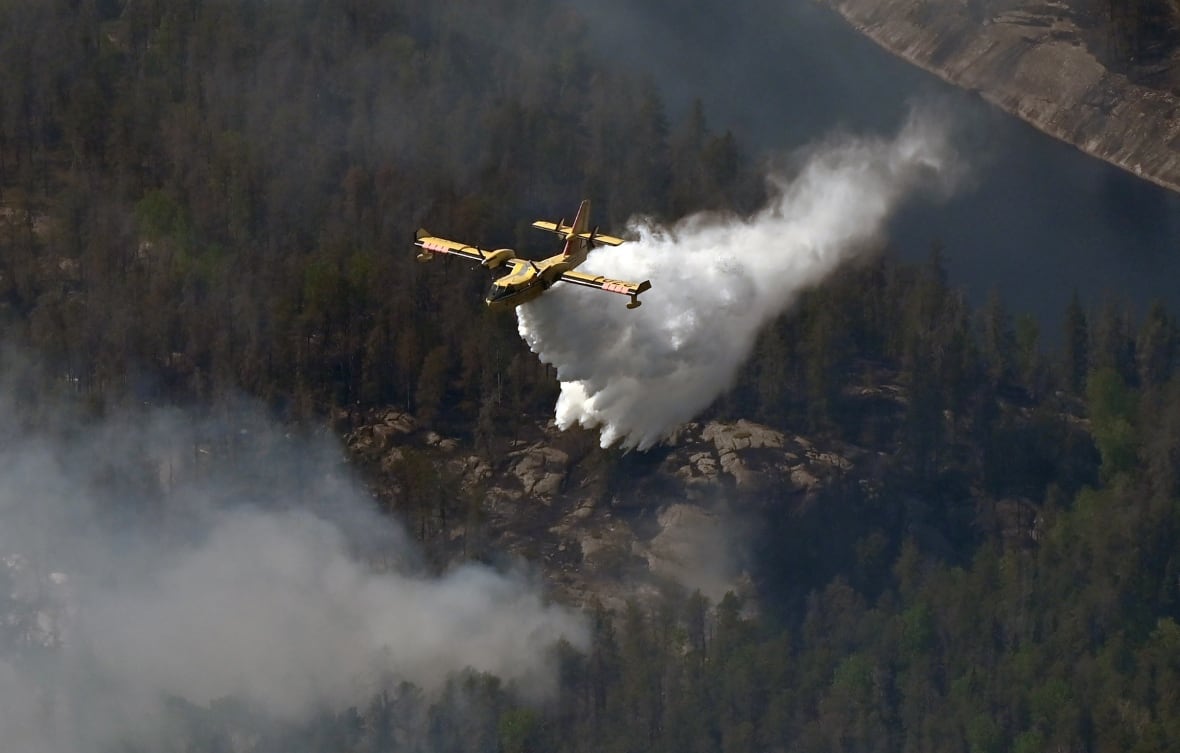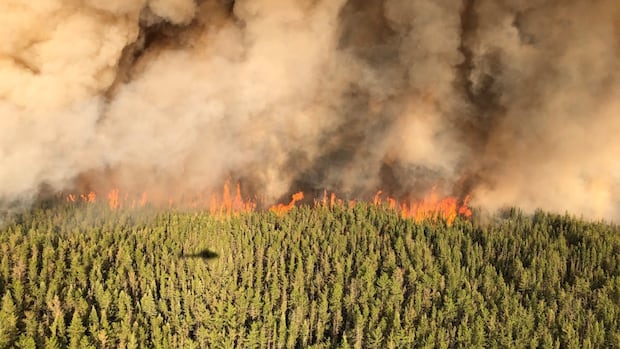[
As wildfires become more frequent and intense across Canada, fire officials are seeing stark differences between northwestern and northeastern Ontario. They say it all comes down to what’s burning, how it burns, and where.
More than 2.2 million hectares have burned in Ontario’s northwest since 2015, according to the Ministry of Natural resources, compared with around 287,000 hectares in the northeast
“The three things that we need to consider when we talk about the differences here, is the climate and the weather, the fuels and the topography,” said Chelene Hanes, a wildland fire research scientist at the Great Lakes Forestry Centre in Sault Ste. Marie.
Northwestern Ontario typically gets a minimal amount of rain, whereas the northeast has a wetter climate and vast peatlands, she explained.
Weather in the northwest region is prairie-influenced, said Alison Lake, a fire information officer with the Ontario Ministry of Natural Resources, in a statement to CBC News.
It’s marked by large and highly convective storm systems — severe local storms associated with thunder, heavy rain, hail, strong winds, sudden temperature changes and lightning — resulting in lightning-caused fires, Lake said.
“On the [northwest] side of the province, and moving into the prairies, they’ve experienced a bit more drought, which is influencing the moisture of the fuels. So that is causing more ignitions to happen as well, because it’s drier,” Hanes said.
Fire cycles

“When we think about the fuel, we’re thinking about the vegetation that burns,” Hanes said.
Hanes explained that the northwest has more tree species like jack pine and black spruce, that are evolved to burn and require crown fires – a wildfire that spreads through the tops of trees and is more intense and faster than surface fires – to open up the seeds to regenerate the forest.
“When they don’t have fire, typically things blow down… because the trees are getting older, there’s potentially insect and disease kill that can happen. So by region, a fire allows the forest to naturally regenerate and to come back,” Hanes said.
She said that if a fire occurs in the same location too frequently, it can disrupt the regeneration process.
“The fire occurs, you get regeneration, and you’re not expecting another fire, say, for another 100 years, or 50 years, something along that line. But then when you’re getting that fire again in 20 years, that’s a problem,” Hanes said.
Lake added the shallow soils in the northwest dry out quickly, allowing for easier ignition and a more rapid spread of fire.
“When such fires do not threaten people, property, or infrastructure, they may be allowed to burn without human intervention to support ecological processes,” Lake explained.
“Large unoccupied areas can lead to larger fires being assigned a status of ‘being observed.’ These fires are actively monitored to allow the natural benefits of wildland fire to occur and will be actioned appropriately if the situation changes,” she said.
In contrast, the northeast contains a large portion of the Great Lake-St. Lawrence forest, which has more deciduous trees – trees that seasonally shed their leaves – which Hanes said are not evolved to burn. Fires in this region tend to stay lower to the ground and burn less intensely.
“The southern portion of the Northeast Region has less volatile forests and more fire resistant hardwood trees,” explained Lake.
She said since there’s more development in the northeast there’s less opportunity for large fires to develop, “enabling rapid detection of new fires due to more people being present on the landscape.”
Fires intensity and frequency
According to data from Ontario’s Ministry of Natural Resources, the northwest saw 324,519 hectares burned in 2023 — nearly three times the total in the northeast, which recorded 116,953 hectares that year.
“2023 was an anomaly, absolutely like that was 4 per cent of our boreal forested land mass, which that’s not sustainable to burn that amount every year, that is something we haven’t seen before,” Hanes said.
Nathan Gillett, a research scientist with Environment and Climate Change Canada, said 2023 was the largest area burned in the country on record by a large amount with more than 15 million hectares burned, double the previous record.
“Those kind of years are going to become more common in the future, as the climate continues to warm,” Gillett said.
As of early July this year, northwestern Ontario has seen 381,397 hectares of forest burned, compared to just 6,856 hectares in the Northeast.
“Climate change has significantly increased the risk of extreme wildfire seasons of large area burns almost everywhere in Canada and across Ontario. In parts of Ontario, it’s more than doubled the risk already going into the future,” Gillett said.
Unlike other parts of the country that are experiencing an increase in fires at the same location, preventing the regrowth of vegetation, Hanes said northern Ontario hasn’t seen “any major changes.”
“That’s not to say that it can’t happen here in Ontario,” she added.
Impact of climate change
Gillett said the biggest effect of climate change on wildfire risk is the warming of temperatures, which dry out the forest more quickly.
Fires of greater intensity are also becoming more common across Canada, according to Hanes.
“So really intense fires that can start to cause their own weather, like pyrocumulonimbus type events, where these fires are creating thunderstorms,” she said.
Climate change studies have indicated that Canada is generally seeing an increase in the area burned and an increase in the number of fires and according to Hanes, Ontario isn’t immune.
“In Ontario we would see initially wetter conditions… some increases in precipitation, particularly in the northeast,” Hanes said.
“But climate change studies have shown that eventually the increases in temperature will override the increases in precipitation. We’re seeing that happening in the data.”
Hanes, who’s been working with the Great Lakes Forestry Centre since 2008, said she isn’t looking forward to the years ahead.
“I think just the pace at which things are changing is really overwhelming,” she said.
“When I first started with the fire group it was kind of one offs, like we had one bad fire year, and then it was quiet… But it seems like each year now we’re having a bad fire year, and it’s one province or another province.”
